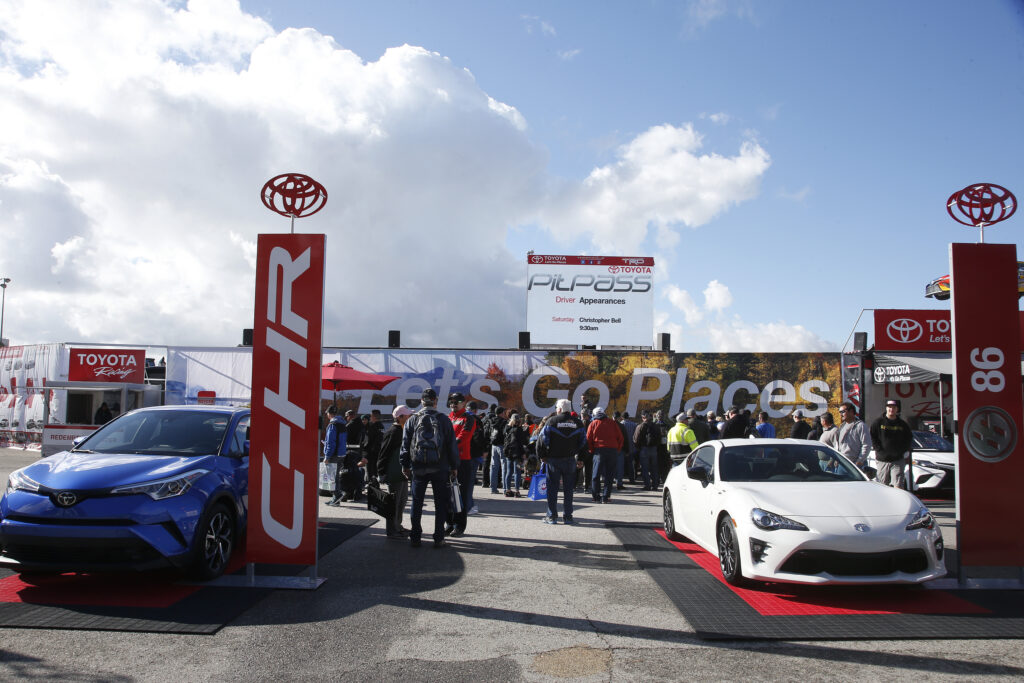
An adage amongst automobile manufacturers goes, “Win on Sunday, sell on Monday.” Toyota Racing has taken this adage to another level, giving fans a one-of-a-kind opportunity to step into the driver’s seat during NASCAR Cup races. Through its Toyota PitPass activation, Toyota allows fans to experience life as a NASCAR driver from training through pit road.
“Toyota Racing does activations at approximately 25 tracks throughout the United States during the NASCAR season,” Toyota Motorsports’ marketing manager, Mike Childs, told RULING SPORTS. “Our main focus is interacting with consumers and hopefully giving them a taste of what Toyota is all about beyond racing and into our production side.”
To do this, Toyota Racing has built an expansive activation footprint, which gives fans the opportunity to test their tire changing abilities in a pit road virtual reality experience, meet their favorite driver and snap pictures in front of legendary Toyota Racing vehicles, and see and touch firsthand the latest Toyota consumer models.

One aspect of the activation that has gained wider consumer engagement is a virtual reality station in partnership with Arris Racing, who along with Toyota Racing sponsors NASCAR Cup series driver, Daniel Suarez.
“In the virtual reality experience, fans get a chance to be part of the pit crew. This experience lets them change the tires on the race car,” Childs explained. “We activated this a year-and-a-half ago at Daytona and have modified it quite a bit, as virtual reality technology has gotten better. Before the changes we would have 75-to-80 people who would engage with the display, but now it’s up to about 225 people. NASCAR is always trying to bring up young fans and this is one way we’re accomplishing that.”
Expanding its virtual reality offering is just one way Toyota Racing is creating greater engagement with consumers through NASCAR.
“During race weekends we see anywhere between 500 to 1,800 people on Fridays, because there’s a smaller crowd present at the track. On Sundays, we see 1,800 people in our activation space,” Childs noted.
From a marketing perspective, the breadth of people who engage with the activation space allows Toyota Racing to capture unique data that can translate into increased sales in the days following a big race.
“When they initially enter the activation area, we ask guests to register with their name, address, email address, phone number and information on if and when they’re in the market for a Toyota product,” Childs said. “Once they register, they get a business card with a QR code on it. Inside of the PitPass there are different places where they can scan the card, so we know where they are in our display.”

This collected information proves critical to Toyota from a sales perspective.
“We will mine the information and use it for many different things,” Childs remarked. “If a customer says they’re interested in buying a Toyota in the next 30-days, the information goes directly to their local dealer within 48-hours to contact the customer. We also use the information to do an RDR match-back. The data shows us where a consumer has interacted with Toyota, for instance at concert, NASCAR or auto show activations. This information will go into our database and allow us to later invite customers to events relevant to them.”
While data collection is a major benefit gained by Toyota through hosting the activation, consumers who attend the activation can benefit by learning how they can modify their consumer Toyota automobiles to more closely resemble those driven by their favorite racers.
“At the activation we have a morph car, which shows the close resemblance of the Camry production car to the NASCAR Camry,” Childs explained. “It’s amazing that Toyota can produce a car that’s track ready. There is little modification made to the cars on the track. The modifications generally include brakes, wheels, suspension and exhaust systems, all items that consumers could modify their cars with. We try to get consumers to resonate between a race car and production car to see that they can buy something close to the race car.”
At the end of the activation, Childs notes that Toyota, “does see sales go up on Mondays, because [it] showcases so many cars over race weekend.”
Along with granting consumers greater access to race cars and drivers, Toyota is also working to expand opportunities in racing for people of diverse backgrounds.
“We have a young driver development program where we have drivers as young as 11-years-old competing in regional series,” Toyota Racing Development senior vice president, Tyler Gibbs, said.
Through the development program, Gibbs says the goal is to find, “the best driver available,” but that Toyota Racing wants to ensure opportunities exist for drivers of diverse backgrounds.
“Ultimately, the teams choose the drivers. It’s about race wins and championships for them,” Gibbs explained. “They tend to be very agnostic about gender and ethnicity, although broadly, Joe Gibbs Racing has been very involved in bringing up diverse drivers. Bubba Wallace came up through Joe Gibbs Racing’s program with Toyota Racing and now Daniel Suarez is a driver for the program.”
Despite the race team possessing decision on whether to sign a driver, Toyota Racing is hopeful more opportunities will emerge for people of diverse backgrounds.
“At Toyota, we have this feeling that the car has no ability to tell what gender or ethnicity you are; all it knows is what you put into it,” Gibbs said. “From our side, we are trying to bring in diverse drivers, because we know there are people out there of diverse backgrounds who are talented enough to drive in the series.”
Get the free weekly newsletter so you can win the game.
